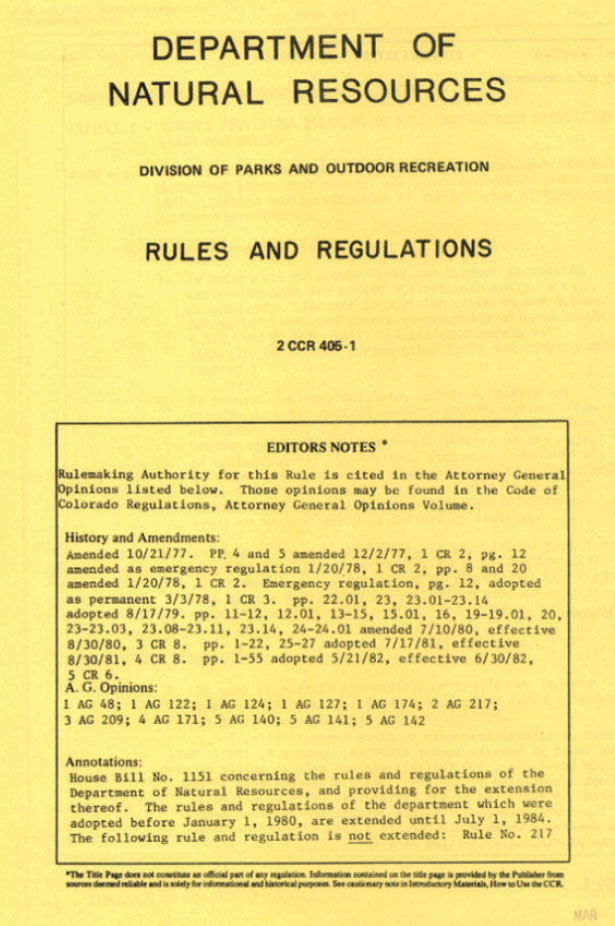
Researching Historic Regulations in Colorado
March 2024
Download This Article (.pdf)
Many Colorado state agencies have been granted rulemaking authority to promulgate regulations to execute the laws enacted by the General Assembly. As a result, some legal issues require researching those regulations. Typically, the focus of regulatory research is on locating current rules and regulations, which was covered in a previous Colorado Lawyer article, “Researching Colorado Regulations.”1 But sometimes a researcher may need to determine what a rule said on a particular date or ascertain when specific language was added, both of which require locating historic versions of the rules. Locating versions of the rules from 2007 to present is relatively straightforward because they are all digitized and located with the current rules. However, finding rules prior to 2007 is more complicated and may require reaching out to the Colorado Supreme Court Library, the Wise Law Library at the University of Colorado, or the Colorado State Archives. Pre-2007 rules are only available in print, and they are not maintained as full versions of the rules due to the nature of how they were updated.
This article provides an overview of where to find historic rules in Colorado, explains how they are maintained, and offers tips for piecing together previous rule versions from the print Code of Colorado Regulations (CCR).
Previous Rule Versions From the Online CCR (2007 to present)
In 2007, the Colorado Secretary of State made the CCR available online, and this became the official version of the rules.2 The rules that were first imported from print to the online CCR were those in effect in late 2006/early 2007. Since that time, the CCR has been amended many times. New rule versions are added to the online CCR as they are updated, and the old versions are retained. As a result, the online CCR contains all versions of the rules dating back to late 2006/early 2007.
Rule versions in the online CCR are located on the same page as the current rules. To access them, select the “Browse” option on the CCR home page, click on the link for the agency issuing the applicable rule, and then click on the link for the rule you are researching. Each rules page includes a table with previous versions dating back to the version imported in 2007 or the version of the rule as originally adopted, if it was adopted after 2007. The links to each version of the rule are listed in reverse chronological order under the heading “Rule version by effective date (PDF).”

The date of each link represents the effective date of that version, and the link opens a PDF file containing that version of the rule in its entirety.
The dated format of the previous versions makes it easy to identify the version of the rule that was in effect on a specific date. But identifying when specific language was added to a rule or amended can be a bit harder. Typically, there is a history section included at the end of each rule.

If you open the current version and scroll to the end, you can review the history to try and identify when certain parts of the rule were amended. From there, you can go back and review the versions for those relevant dates to identify the version in which the language was first added or amended. However, if a rule lacks a thorough history section or does not detail the parts affected by each amendment, you may have to review all the previous versions to identify when the language you are researching was added or amended.
Previous Rule Versions in Print (1978 to 2006)
The CCR began print publication in 1978 and was maintained exclusively in print until the online CCR became available in 2007. The historic rules from 1978 to 2006 have not been digitized and are accessible from three places: the Colorado Supreme Court Library, the Wise Law Library at the University of Colorado, and the Colorado State Archives. Furthermore, unlike the previous versions available from the online CCR, the historic print rules are not typically found as complete versions as they existed at one point in time. As a result, understanding how the CCR was updated in print is helpful for locating historic rules in print.
The CCR was published in print as a loose-leaf treatise, with loose pages stored in three-ring binders. The loose-leaf format made updating the rules easier for the publisher. When a regulation was updated, the publisher only needed to print the page(s) containing the amendments, and the rest of the pages could remain untouched. The Colorado Register (CR) was published monthly and included a supplement with the updated pages to be incorporated into the CCR. The monthly CCR supplement also contained instructions (“filing instructions”) regarding which pages should be removed and what new pages to insert.

Because the publisher only needed to replace pages containing amendments, the replacement pages in the monthly supplement often did not represent each rule in its entirety. For example, if only a small subsection of a rule was amended and only took up part of a single page, the supplement would likely only replace that page, and the rest of the rule pages would remain intact. Furthermore, the pages that were removed (“superseded pages”) also did not reflect the entire regulation as it existed prior to the update. Additionally, the filing instructions did not contain specific instructions regarding how to handle the superseded pages. Most subscribers simply discarded the superseded pages and only maintained an updated version of the CCR. Some libraries chose to keep the superseded pages to maintain a historic record of the rules. But because there were no instructions regarding the maintenance of the superseded pages, those institutions that kept them did not organize them in the same way.
Although there is no uniform system for organizing the superseded pages, there are details contained on those pages, the table of contents, and the filing instructions that can be helpful in identifying historic versions of the rule no matter how they are organized. Each rule starts with a title page printed on yellow-orange paper, which includes the rule history, followed by white pages with the text of the rule. The white rule pages are double-sided and have a CR citation and MM-YY date printed on the top of the front of the page.
The CR citation is formatted with the volume number preceding the “CR” and the issue number following, so a citation to 28 CR 4 refers to volume 28, issue 4. The date and CR citation indicate the monthly CCR supplement in which the page was added, so it provides a general timeframe for any changes made to the rule contained on that page.
More information regarding a rule amendment can be found in the history section on the rule title page. The rule history provides a list of changes to the rule in chronological order. The notes typically indicate which pages were replaced or added with each change and sometimes also detail the specific parts or sections that were amended. Each amendment in the history also provides the effective date of the change and the CR citation indicating which monthly CCR supplement included the replacement pages for that change.

To determine the effective date for a specific page, you can use the CR citation printed on the page and reference it to the amendment in the history notes that has the same CR citation. You can also identify which pages were removed and inserted by reviewing the filing instructions included in each CCR supplement. After reviewing the history notes for a rule, you can use the CR citation to locate the corresponding filing instructions to confirm which pages were removed and inserted as a result of the amendment.
Noting these details about the rules in the print CCR can help with locating historic versions. However, as mentioned above, what exists and how the historic rules are organized varies slightly at each location. That means that researchers may choose to visit different locations to conduct research depending upon their needs, and the strategies they use may vary by location.
Colorado Supreme Court Library
The Colorado Supreme Court Library subscribed to the print CCR for its entire run (January 1978 to September 2019) and maintained all the superseded pages. Each month, when the library received the CR with the CCR supplement, the librarians would remove old pages and insert new pages according to the filing instructions. The pages that were removed would be stamped as “superseded” with the month and year of the update in which they were superseded.
Then all the superseded pages were placed in binders with previously superseded pages. The binders of superseded pages are organized by rule and then by the date superseded. The rules as they existed when the CCR ceased publication in print are kept in green binders, and the superseded pages are maintained in blue binders.
Because the pages of a rule were usually not all replaced at the same time and the superseded pages are organized by date superseded, the pages in the superseded binders usually do not reflect a full version of a rule for any particular date. Occasionally, a rule would be replaced in its entirety, so the pages superseded at that time would reflect the full version of the rule prior to the amendment. In that case, the pages of that rule version can be found together in the superseded binders. However, because that was not commonplace, you must often use other methods to locate historic versions.
It’s often easier to narrow your focus to specific sections or parts to trace back, rather than trying to piece together a historic version of the entire rule. To do so, you could review the history notes to identify all the dates in which the section or part was likely amended. However, the history notes often only identify the changes by page number instead of by section. Instead, it is possible to trace the history of a single rule page back using the rule page itself, because the dates provided on the page create a chain of succession. As mentioned above, the front top of the page has the date and citation for the CCR supplement in which the page was added. The date added corresponds with the date the previous page was superseded, so you can use those dates to identify each previously superseded page.
To do this, you would begin by reviewing the version of the rule as it last existed in print. Once you identify the page(s) with the relevant sections or text, you would note the month and year printed on the front top of the page. Then, you would go to the superseded binder(s) for that rule and use the previously noted month and year to find the pages superseded at the time the other page was added. Among that set of pages, you should be able to find the page with the relevant section representing the version that immediately preceded the page with which you started. Then you could use the date printed on the newly found superseded page to identify when it was added and, subsequently, when the next preceding version of the page was superseded. If you are trying to find specific language from a set date, repeat this process until you find the relevant page that would have been in effect for that date. One way to confirm that you have found the correct page is to think about the date printed on the top of the page and the superseded date stamped on the bottom of the page as the date range in which that page was considered current. If the date you are researching falls between those two dates, you have likely found the relevant page. If you are researching historic versions to identify when specific language was added to a rule, you would repeat the process of tracing back the page until you find the page in which the language first appeared. Note that a particular section or rule may not have been amended even if the page was replaced because the amendment could have affected a different section that appears on the same page. Then, you can use the CR citation printed on the page to find the relevant entry in the history notes on the rule title page and identify the effective date of that amendment.
The process can become more complicated when the section appears on multiple pages or you are researching more than one section, because it is possible the pages were not always superseded at the same time. When that happens, you can follow the general steps above, but you must keep track of all the various pages together. You would start by finding the relevant rule pages as they last existed in print and note the date they were added. If all the pages were added on the same date, then you would go to the rule pages that were superseded on that date and repeat the process until you find the pages for the relevant date. However, if at any point the various pages were not added and superseded on the same date, you might need to locate the pages from different sets of superseded pages and combine them.
For example, if you were researching Rule 6.4 of 4 CCR 703-3, you would find that the last version of the rule in print appears on both pages 4 and 5. Furthermore, you would find that those two pages were amended and added into the CCR at different times: page 4 was added in December 2012 and page 5 was added in September 2016. So, you would start by going to the superseded pages from September 2016 to find the previous page 5 and then add it to page 4 from December 2012 to piece together that section as it appeared prior to September 2016. From looking at the date printed on the top of the page 5 that was superseded in September 2016, you would see that it was added in August 2016. So you would move on to the pages superseded in August 2016 to find the preceding page 5 that you would again add to the page 4. Eventually, you might come to a page that was added at the same time as or prior to the other page, but you would continue to keep the pages together and trace back page by page.
A benefit of the Colorado Supreme Court Library keeping the superseded pages loose in binders is that it is possible to pull various pages together to create a set of pages that were in effect at the same time but were not superseded at the same time. The downside is that researchers may inadvertently place pages out of order in the binders, or pages could go missing. Additionally, because the pages were filed and stamped by librarians, there is always a chance of human error. After identifying the relevant page(s), researchers should review the history notes and filing instructions to verify that the page(s) was, in fact, in effect for the given date.
If necessary, it is possible to pull the entire version of a regulation as it appeared on a set date. One way is to review the history notes and filing instructions to create a list of pages and the date each page was superseded subsequent to the date you are researching. Then, you could use that list to pull the relevant superseded pages together and create the version as it existed at a set date. When doing this, it is important to confirm that all the pages would have been considered current for the set date by reviewing the date added and superseded on each page to ensure the date you are researching falls into that date range for each page. If the rule you are researching is quite long or only a few pages of the rule were replaced with each amendment, it could take a long time to review all the superseded pages and pull the correct pages together, so it is important to plan accordingly.
Wise Law Library
The Wise Law Library at the University of Colorado also subscribed to the print CCR for its entire run; however, its superseded pages are maintained slightly different than those at the Colorado Supreme Court Library. Upon receiving the monthly supplement, the librarians inserted new pages and removed old pages from the CCR, as instructed. From there, they kept all the pages superseded by that monthly supplement together and sent them to a bindery to be bound with the corresponding filing instructions. The bound volumes have the CR volume and issue number and the month and year in which the pages were superseded on the spine.
Because the pages are organized by date superseded and then by rule number, you may need to approach researching the rules in this collection slightly differently. You can still trace the history of a single page as described above, using the date printed on the top of the page to identify the next volume in which you would find the previously superseded page. However, when trying to pull a full version of the rule or even a section that consists of pages superseded at different times, you would need to make copies of each page from the various binders to pull them together as a single version. Because the pages are bound, there is not the same concern about pages going missing or being placed back into the binders erroneously. Additionally, the superseded volumes at the Wise Law Library are kept in their closed stacks, so they are well preserved. If you would like to research historic regulations at the Wise Law Library, please contact a librarian beforehand for assistance.
Colorado State Archives
Unlike the rules at the Colorado Supreme Court Library and the Wise Law Library, which derive from the CCR, the rules at the Colorado State Archives are the rulemaking files from the Colorado Secretary of State’s Office. Per the State Administrative Procedure Act (APA), state agencies must send the adopted rule, along with the corresponding Attorney General (AG) opinion, to the Colorado Secretary of State.3 The packets with the adopted rule and AG opinion were maintained in folders organized by agency and year, and were eventually sent to the Archives for preservation. Often, the adopted rules that the Secretary of State received only detailed the specific amendments being made. As a result, the rules at the Archives usually do not exist as complete versions of the rules nor do they often even provide the full text of a section, so they would likely not be useful for researchers seeking to find the full text of a rule for a given date. However, because they highlight the specific changes to a rule, they are a great resource for tracking dates of specific changes.
The Colorado State Archives are available by appointment only, so researchers must first make a request. When requesting rules from the Archives, you should indicate the state agency, the year or years of the rulemaking, and the CCR citation of the final rule. You then have the option to have the Archives send you the files for a fee or to have the files pulled so that you can review them onsite.
Locating Rules Prior to 1978
As detailed in “Researching Colorado Regulations,” the regulations prior to 1978 were not organized in a code.4 Those rules could be in many various locations, and there is a chance that they were not properly preserved.
From 1969 to 1978, the APA required the Secretary of State to publish a “Colorado regulations register” that would include notices of rulemaking, final rules, and the corresponding AG opinion.5 The agencies were required to provide anything to be published in the regulations register to the Secretary of State, who would distribute the same to those required by statute and anyone who requested to receive the regulations register. The Colorado Supreme Court Library was one of the statutorily required recipients. Additionally, the Secretary of State has sent all its files from this time to the Archives. As such, rules from 1969 to 1978 may be located at either the Colorado Supreme Court Library or the Archives. The collections at both locations may not be complete, so it is best to reach out to them with the name of the state agency and the desired years to find out what each institution may have.
From 1959 to 1969, the state agencies were required to make their rules available to the public and to publish them by sending copies to the AG and anyone else who requested copies of the rules. Sometimes the agencies published those rules in rule pamphlets, and some of these pamphlets can be found at various libraries,6 including the Colorado State Publications Library and the Norlin Library at the University of Colorado. Many state agencies have also provided their historic records to the Archives. The Archives may have rules from this period if the agency maintained their rules records and provided them to the Archives. Prior to 1959, there was no uniformity regarding the publication of rules. However, there are some rule pamphlets available in various libraries for this time frame.7 Additionally, researchers can contact the Archives to find out what records they have for each agency prior to 1959.
Conclusion
Determining how best to locate previous versions of rules and regulations in Colorado depends on the year of the rule or regulation: Rules issued from 2007 to present are easily found online. Rules issued from 1978 to 2006 can be found at the Colorado Supreme Court Library, the Wise Law Library, or the Colorado State Archives. And rules and regulations issued prior to 1978 may no longer be available but can sometimes be found at local libraries or the Colorado State Archives. When in doubt, reach out to your local law librarian for assistance.
Related Topics
Notes
1. Hales, “Researching Colorado Regulations,” 52 Colo. Law. 14 (Nov. 2023), https://cl.cobar.org/departments/researching-colorado-regulations.
2. CCR, https://www.sos.state.co.us/CCR/Welcome.do.
3. CRS § 24-4-103(11)(d).
4. Hales, supra note 1 at 15.
5. CRS 1963 § 3-16-2(11) (1969 Perm. Cum. Supp.) (added by Ch. 33, Sec. 3, 1969 Colo. Sess. Laws 81).
6. See e.g., Colorado State Board of Education, Policies, Procedures, Regulations of the State Board of Education of Colorado (1959), available in the Colorado State Publications Library at https://athena.cde.state.co.us/record=b1018725~S1.
7. See e.g., Colorado State Athletic Commission, Laws, Rules, and Regulations Governing Professional Boxing, Amateur Boxing, and Wrestling (1954), available in the Colorado State Publications Library at https://athena.cde.state.co.us/record=b1023035~S1.


